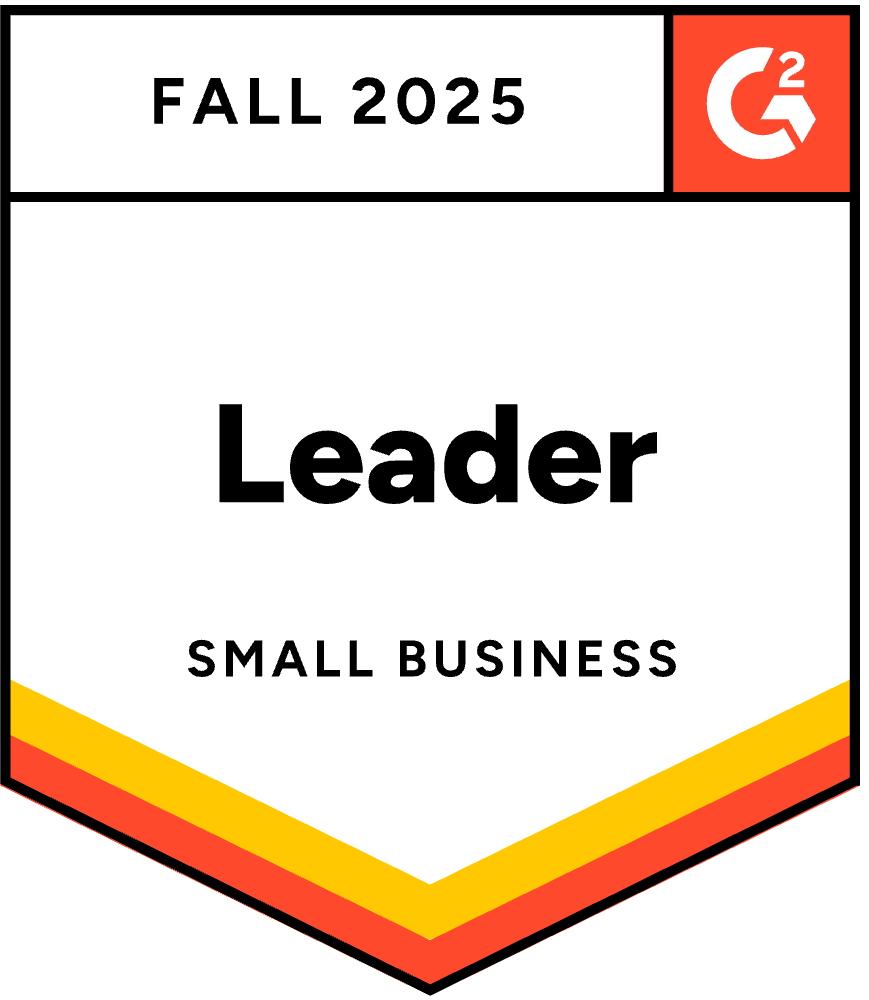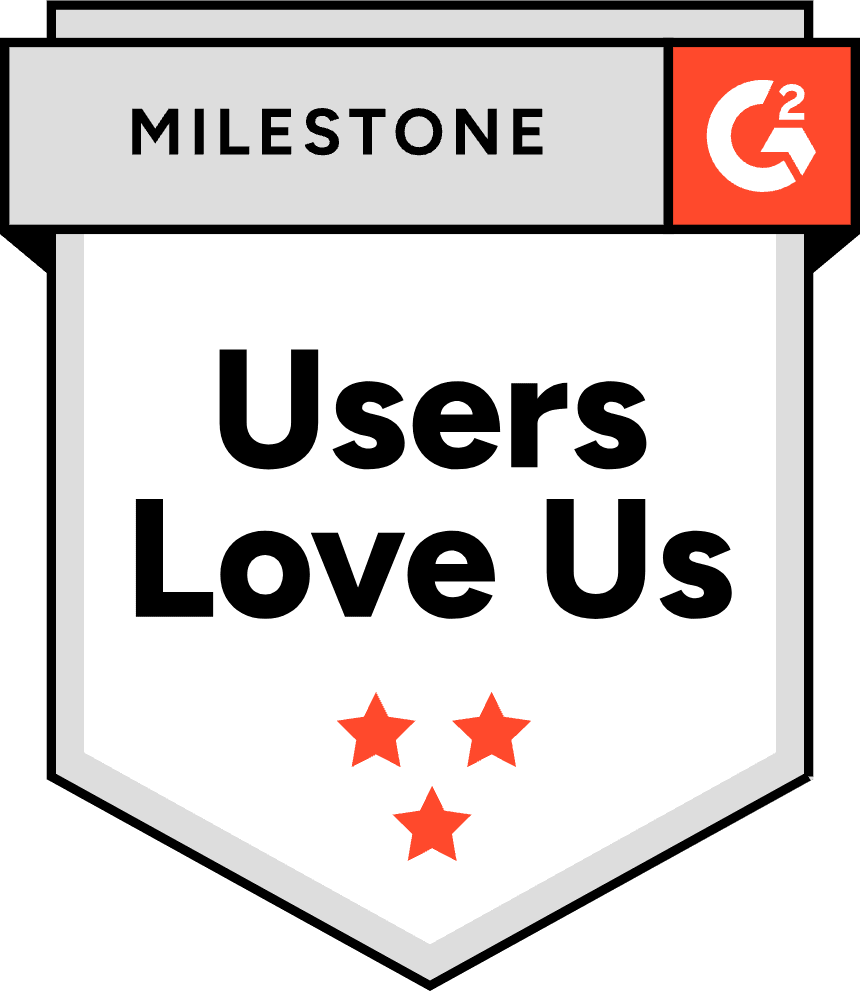Are your sales pitches falling on deaf ears? You’ve rehearsed your script, researched your prospects and followed up like clockwork—yet deals still slip through your fingers. It’s a frustrating cycle that leaves you feeling defeated and questioning your strategy, watching competitors with a modern playbook win the deals you should be closing.
But it doesn’t have to be this way. In this guide, we break down over 27 proven sales tactics—categorized by sales stage—from prospecting and engagement to closing. These are the specific, intentional actions that sales professionals use to build trust, overcome objections and dominate their market in 2025.
Let’s get started.
Quick Links to Effective Sales Tactics
- What Are Sales Tactics?
- Sales Tactics vs. Sales Strategy: What’s the Difference?
- Prospecting & Lead Generation Tactics
- Engagement & Qualification Tactics
- Closing Tactics
- Psychological & Trust-Building Tactics
- Future-Focused & Tech-Driven Tactics
- How to Choose the Right Sales Tactics for Your Team
- Key Tools to Power Your Sales Tactics
- How to Measure the Effectiveness of Your Sales Tactics
- 5 High-Pressure Sales Tactics to Avoid at All Costs
- Frequently Asked Questions
What Are Sales Tactics?
Sales tactics are the specific, intentional actions and methods that salespeople use to implement a broader sales strategy and persuade potential customers to make a purchase. These are the concrete steps taken during the sales process to build trust, answer questions, overcome objections and inspire confidence in the buyer.
There are many different sales tactics that can be used throughout the customer journey. The best sales tactics are those that adapt to each situation, prioritize customer trust, and are tailored to the prospect’s needs.
Examples include offering limited-time discounts, using customer testimonials, providing product demos and asking specific questions to uncover needs. While your sales strategy defines what you want to achieve and why, your tactics define exactly how you’ll get there—one conversation, one email, one call at a time. Ethical selling, as opposed to unethical selling, focuses on honesty and value-based approaches that help close deals while building long-term customer trust, whereas unethical selling relies on manipulative tactics that can damage trust and reputation.
Ethical selling helps you establish a reputation for being trustworthy and reliable.
Sales Tactics vs. Sales Strategy: What’s the Difference?
Sales strategy is the high-level, long-term plan that answers ‘what’ an organization wants to achieve and ‘why’. It defines overall objectives, target customers and value proposition. Sales tactics are the specific, short-term actions and methods used to execute the strategy—the ‘how’.
Think of it this way: If the strategy is the destination for a trip (where to go), the tactics are the specific modes of transport and routes you take to get there (how to get there). For example, your strategy might be to penetrate the mid-market SaaS sector. Your tactics would include cold calling decision-makers, sending follow-up emails with case studies, offering free trials or using the SPIN selling method to uncover pain points.
A strong strategy without effective tactics is just a plan. Effective tactics without a clear strategy waste time and resources. You need both.
A strong strategy without effective tactics is just a plan. Effective tactics without a clear strategy waste time and resources. You need both.
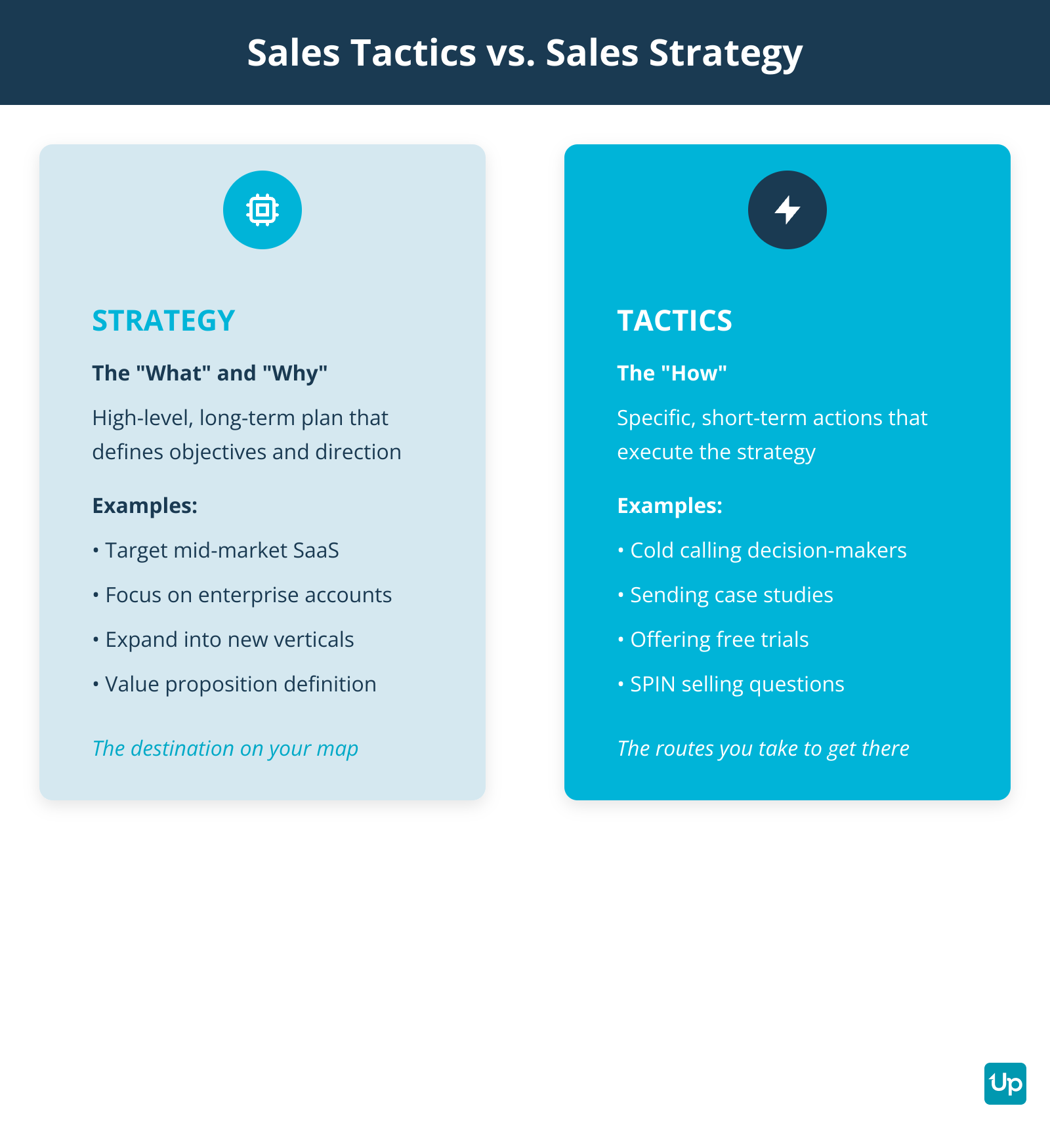
Sales Tactics vs Sales Strategy Comparison
Prospecting & Lead Generation Tactics
Getting in front of the right people is the foundation of all sales success. Modern B2B buyers are more informed than ever, using an average of 10.2 channels in their journey. Research from Gartner shows that 77% of B2B buyers described their latest purchase as very complex or difficult, with a typical buying group involving six to ten decision-makers. Modern buyers also prefer to conduct independent research before engaging with sales representatives.
To attract and find prospects effectively, it’s crucial to leverage content marketing and inbound selling strategies. These approaches use valuable content, SEO, social media, or email to draw in leads and build trust before direct outreach.
This complexity means you can’t afford to waste time on the wrong prospects. Here are the tactics that help you identify and connect with high-potential leads, including cold outreach to engage cold leads—be sure to personalize your communication to increase response rates and avoid generic messaging.
Sales and marketing teams should collaborate closely to generate and qualify leads, often using lead scoring systems within CRM platforms. Building a sales pipeline allows both teams to easily keep track of the status of each potential deal and manage prospects through every stage. Additionally, using buyer intent signals helps prioritize outreach to the most interested leads, ensuring your efforts are focused where they matter most.
1. Build a Data-Driven Ideal Customer Profile (ICP)
An Ideal Customer Profile (ICP) is a detailed, data-driven definition of the type of company that derives the most value from your product and provides the most value to your business. It is a description of an organization, not an individual person (which is a ‘buyer persona’).
Building a data-driven ICP is a foundational strategic step before any outreach begins. Start by analyzing your best current customers—those with high lifetime value, high satisfaction and low churn.
Key data points to collect fall into several categories:
- Firmographics: Industry, company size (employees), annual revenue, geographic location
- Technographics: The technology stack the company uses (e.g., CRM, marketing automation platforms)
- Behavioral Data: How they engage with your brand, their buying process, product usage patterns
- Pain Points & Goals: The specific challenges your product solves and the objectives they aim to achieve
Once this data is collected from sources like your CRM, customer interviews and sales team feedback, identify common patterns to build a clear, documented profile. This strategic profile then guides all go-to-market efforts, from marketing messaging to sales targeting.
Tools like UpLead can accelerate this process by providing access to a database of over 180+ million business contacts with 50+ search filters, ensuring you connect with the right decision-makers.
2. Leverage Social Selling on LinkedIn
Social selling is the strategy of building relationships and credibility on social media platforms to find, connect with and nurture sales prospects. It’s not about scheduling posts—it’s about active engagement.
Here’s how to do it:
Optimize Your LinkedIn Profile: Transform your profile from a resume into a resource for your target audience. Use a professional photo, a value-proposition headline (what you do and for whom) and a detailed summary that outlines how you help clients.
Strategically Build Your Network: Use LinkedIn’s advanced search filters or Sales Navigator to efficiently find prospects by identifying and connecting with the right people based on your ideal customer profile. Send personalized connection requests that reference a shared interest, recent post or mutual connection to increase acceptance rates.
Create and Share Valuable Content: Post content that provides value and insight to your target audience. Follow the 80/20 rule: 80% of your activity should be engaging with others’ content, while 20% is sharing your own.
Engage Authentically: Leave thoughtful comments on prospects’ posts to warm them up before outreach. The goal is to be seen as a trusted advisor, not just a salesperson.
Use LinkedIn Tools: Utilize LinkedIn Groups to network and participate in industry discussions. Use LinkedIn Sales Navigator for advanced lead filtering, lead recommendations and tracking buyer interest signals.
Sales leaders with a high LinkedIn Social Selling Index (SSI) create 45% more sales opportunities and are 51% more likely to achieve their sales quotas.
3. Master Cold Email Personalization at Scale
The average user deletes 48% of the emails they receive without even opening them. Engaging cold leads is especially challenging, making it crucial to personalize your cold outreach and add tailored touches to increase response rates.
A sales cadence is a structured sequence of outreach activities used by sales reps to connect with and nurture prospects. It’s a predefined schedule of touchpoints across multiple channels, such as email, phone calls, social media and even SMS or video messages.
A typical B2B sales cadence might last between 10 and 21 days and include 8 to 17+ touchpoints. For example, a 14-day multi-channel cadence could look like this:
- Day 1: Personalized email
- Day 3: LinkedIn connection request
- Day 5: Phone call with voicemail
- Day 7: Follow-up email with a valuable resource
- Day 10: Engagement on a LinkedIn post
- Day 14: Final follow-up email or video message
The key is to add value with each interaction rather than simply ‘checking in’. This structured approach eliminates guesswork for reps, ensures consistency and allows for performance tracking.
Make sure all of your emails are crafted via constant testing. Use intriguing subject lines and pay special attention to your opening line.
Here are a few examples of ways to increase engagement with your subject lines:
- Urgency and scarcity: Change from “Our sale expires on the 22nd” to “Last hours to get up to 70% off!”
- Personalization: Change from “Please fill out this satisfaction survey” to “We’d love your feedback [RECIPIENT’S NAME].”
- Informational topics: Change from “New product lineup” to “Get a first look at our new product!”
- Engaging lists: Change from “Tips to increase mobile’s battery life” to “Top 10 tips to boost your phone’s battery life.”
Test different copy variations and keep an eye on email opens, link clicks and maintaining an organized inbox to spot the right responses. Try an A/B email tool like HubSpot’s Email Template Builder to speed up the process.
Once you’re ready to send your email, schedule them to arrive at the right time. Most prospects want to read emails at 5 or 6 a.m. And if you want a response, pay close attention to follow-up emails.
4. Refine Your Cold Calling with a Value-First Approach
According to research by GlobalCallForwarding, 57% of customers feel that call support is their first and most comfortable preference for communication. However, effective sales cadences now require 8 to 12 touchpoints across multiple channels like email, phone and social media, often spread over two to four weeks. Using a multi-channel approach can increase customer engagement rates by 287% compared to single-channel methods.
Cold calling is hard and unpleasant. You need to prepare your team if you want them to succeed.
Train your salespeople: Teach your salespeople to embrace rejection. It will happen. Let them know it’s never personal; it’s just part of the job. A script can be a powerful way to perfect your sales pitch. It gives your salespeople proper guidance and great sales negotiation tactics to common objections. Train your salespeople to follow the script like actors. They may end up reciting it a hundred times, but each lead will only hear it once, so they need to make each count.
Help your sales team see your leads as real people: A great way to keep your salespeople engaged in their call is by helping them picture who they’re calling via rich customer profiles. This tactic can help your salespeople get to know your leads and discover who they are behind their names and job title.
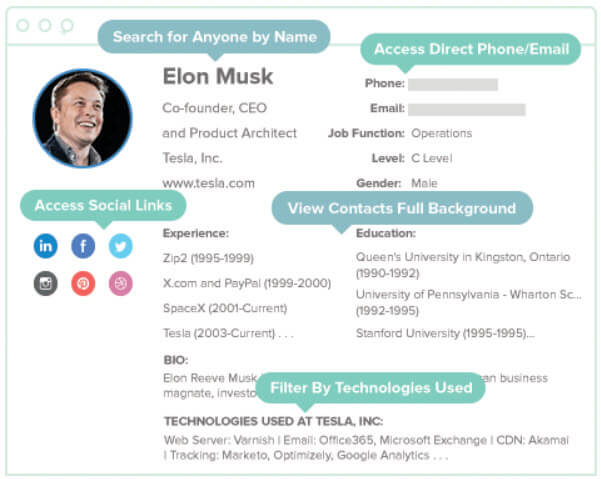
Leave effective voicemails: Cold calls will result in a voicemail over 90% of the time. Try to keep voicemails under 30 seconds and make them engaging and friendly. Use your lead’s name and information when appropriate and give them a great reason to return the call.
Don’t forget to keep track of your cold calls through your CRM. By crafting a clear and unique tool to keep track of your whole team’s performance, you’ll be able to find better ways to reach your customers and improve your strategies.
5. Generate and Nurture Referrals
Referral marketing generates 3 to 5 times higher conversion rates than other channels. Referred customers have a 37% higher retention rate and their lifetime value is 16% higher than non-referred customers. In B2B, 84% of decision-makers start their buying process with a referral.
Build a strategy for asking your current customers for referrals. If you want to get referrals, prioritize asking in person instead of via email or phone. Take time to talk to them face-to-face and ask for referrals in a tactful way.
Here are a few examples of the way you can ask for referrals without seeming pushy or desperate:
- “Is there anyone else you think we can help?“
- “Do you know anyone who’s having the same issues?“
- “Do you have any friends who need this solution but don’t know it yet?“
Once you have a referral, craft your outreach plan. Don’t treat them like any other cold call. Remember that these are qualified leads. When contacting referrals, be persistent until you’re sure they won’t buy from you and keep the person who referred them to you in the loop.
6. Use ‘Pattern Interrupts’ in Initial Outreach
A pattern interrupt is a technique that disrupts a prospect’s expected pattern of communication to capture their attention. Instead of starting with “I hope this email finds you well,” try opening with a provocative question, a surprising statistic or a reference to a specific pain point you know they face.
For example: “I noticed your team just posted three job openings for SDRs. Scaling that fast?” This unexpected opener forces the prospect to pause and engage, rather than deleting your message.
7. Identify and Act on Buyer Intent Data
Buyer intent data reveals which companies are researching solutions like yours. By tracking online behavior—such as content downloads, website visits and search queries—you can identify prospects who are in-market right now.
Platforms like TechTarget and ZoomInfo provide intent signals that allow you to prioritize outreach to companies showing active buying signals. This increases your chances of connecting with prospects at the right moment in their buying journey.
8. Deep Prospect Research (Psychographics over Demographics)
Demographics tell you who your prospect is. Psychographics tell you why they buy. Go beyond job title and company size to understand their motivations, challenges, values and preferred communication style.
Review their LinkedIn activity, blog posts they’ve written, podcasts they’ve appeared on and the content they share. This level of research allows you to craft outreach that resonates on a personal level and positions you as someone who understands their world.
9. Track Sales Triggers for Timely Outreach
Sales triggers are events that signal a company may be ready to buy. Examples include new funding rounds, executive hires, office expansions, product launches or mergers and acquisitions.
Set up Google Alerts, use LinkedIn Sales Navigator alerts or leverage tools like Crunchbase to monitor these events. When a trigger occurs, reach out with a message that ties your solution to their new initiative. Timing is everything.
Lead generation doesn’t have to be all that painful. With UpLead, you can easily connect with high-quality prospects and leads to grow your company.
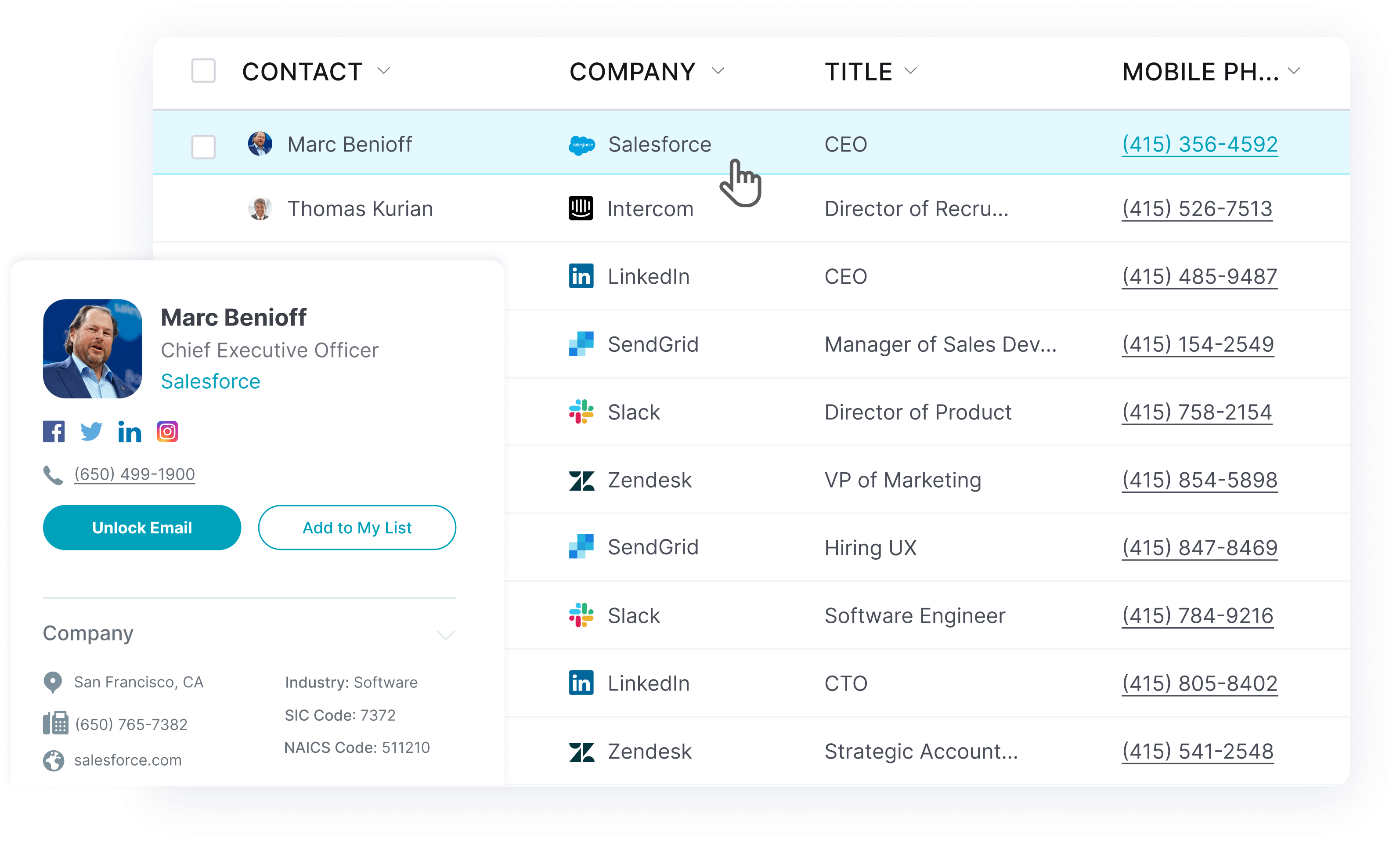
Engagement & Qualification Tactics
Once you’ve connected with a prospective customer, the next challenge is to engage them in a meaningful conversation and qualify whether they’re a good fit. The discovery call is a crucial consultative opportunity to understand the prospective customer’s needs, provide valuable insights, and begin building trust. An account executive plays a key role in guiding prospects through the sales process and facilitating cross-team communication to ensure a seamless experience. Building a solid relationship with prospective customers by being empathetic, honest, and forming genuine relationships is essential for fostering long-term loyalty. Handling objections is a critical aspect of engagement, requiring understanding, empathy, and effective responses to customer concerns. Providing valuable insights during sales conversations helps build trust and demonstrates a genuine interest in solving the buyer’s problems. In modern B2B sales, building trust and providing tailored value are essential for sales effectiveness.
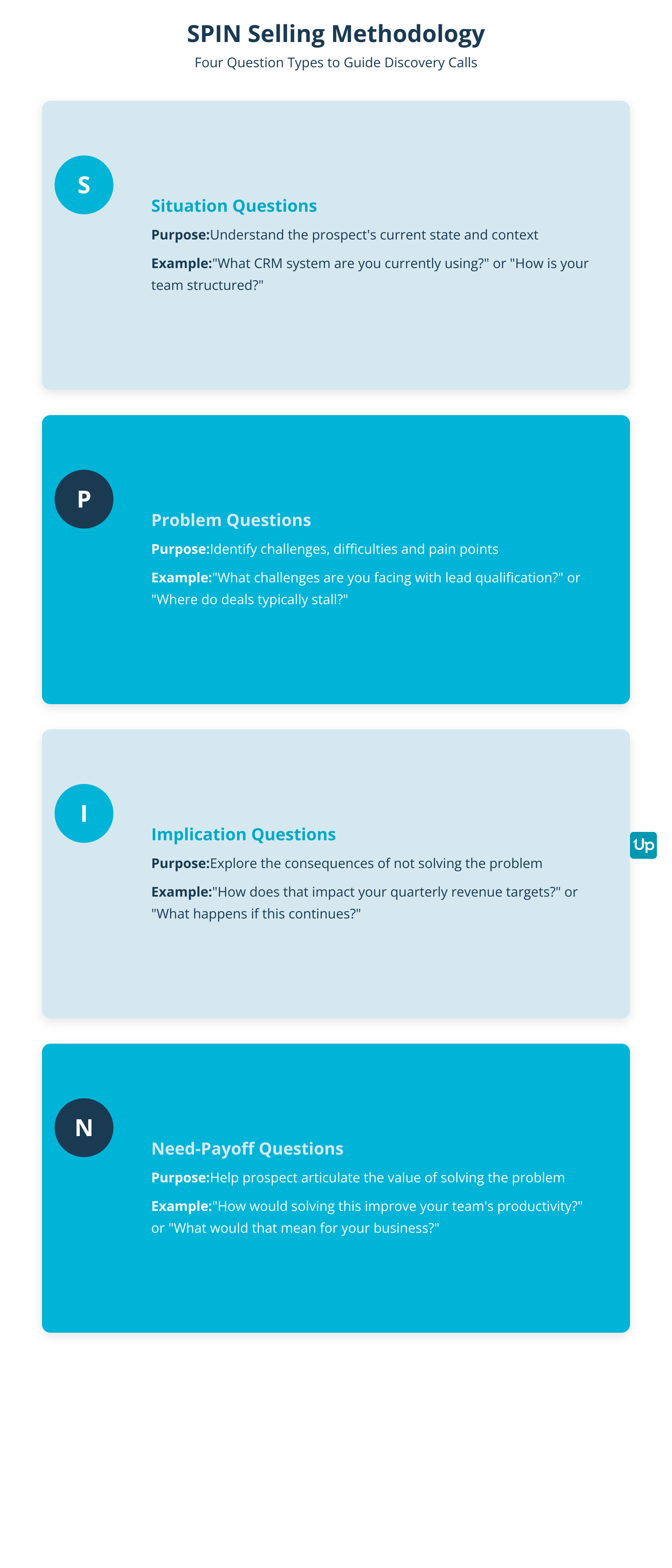
SPIN Selling Question Framework
10. Use the SPIN Selling Methodology to Uncover Pain
SPIN Selling is a proven sales methodology that is especially effective during the discovery call, which is a crucial initial conversation with a prospect. It uses four types of questions to guide discovery calls:
- Situation: Understand the prospect’s current state
- Problem: Identify challenges and pain points
- Implication: Explore the consequences of not solving the problem
- Need-Payoff: Help the prospect articulate the value of solving the problem
During the discovery call, it’s important to use open-ended questions to understand customer needs and uncover pain points and motivations. This approach helps you address the prospect’s concern, build trust, and facilitate the sales process.
This framework ensures you’re not pitching too early. Instead, you’re guiding the prospect to realize the urgency of their problem and the value of your solution on their own terms.
11. Adopt The Challenger Sale Model: Teach, Tailor, Take Control
The Challenger Sale model is built on the insight that the most successful sales reps don’t just build relationships—they challenge their prospects’ thinking. The approach has three core steps:
- Teach: Offer unique insights that reframe how the prospect thinks about their problem
- Tailor: Customize your message to the prospect’s specific situation and economic drivers
- Take Control: Guide the sales process and push back on objections
This methodology is effective in complex B2B sales where buyers need to be educated and led to a decision.
12. Practice Active Listening and Reflective Rephrasing
Top-performing sales professionals listen more than they talk. Active listening means concentrating on what the prospect is saying, rather than just waiting for your turn to speak.
Active listening is crucial for handling objections and showing that you genuinely care about the prospect’s needs. By truly understanding and empathizing with customer concerns, you can address objections more effectively and build stronger relationships.
Use reflective rephrasing to confirm understanding: “So what I’m hearing is that your biggest challenge is X and that’s costing you Y. Is that right?” This technique builds trust, ensures clarity and makes the prospect feel heard.
13. Use Personalized Video Pitches for High-Value Targets
Video messages cut through the noise. Tools like Loom or Vidyard allow you to record short, personalized videos where you can reference the prospect’s website, recent news about their company or a specific pain point.
Video humanizes your outreach and creates a stronger connection than text alone. It’s effective for high-value accounts where you need to stand out from dozens of other vendors.
14. Qualify Opportunities with the MEDDIC Framework
MEDDIC is a qualification framework that helps you assess whether a deal is worth pursuing. It stands for:
- Metrics: What is the economic impact of solving this problem?
- Economic Buyer: Who has the authority to approve this purchase?
- Decision Criteria: What criteria will they use to make a decision?
- Decision Process: What steps must happen before a contract is signed?
- Identify Pain: What is the prospect’s critical business issue?
- Champion: Who inside the organization is advocating for your solution?
By answering these questions early, you can forecast more accurately and avoid wasting time on deals that will never close.
15. Multi-Thread by Engaging Multiple Stakeholders
A typical buying group involves six to ten decision-makers. If you’re only talking to one person, you’re at risk. Multi-threading means building relationships with multiple stakeholders across different departments and levels of seniority.
This tactic reduces risk, provides diverse perspectives on the problem and ensures your deal doesn’t die if your single champion leaves the company or loses influence.
16. Turn Discovery Calls into Consultations
Stop treating discovery calls as interrogations. Instead, position yourself as a consultant who is there to diagnose problems and prescribe solutions. Share valuable insights, offer best practices, and provide value even if the prospect doesn’t buy.
Sharing valuable insights during consultative selling not only demonstrates your expertise but also builds credibility, helping prospects see you as a trusted advisor.
This consultative approach builds credibility and trust, making it more likely that the prospect will view you as a partner rather than just another vendor.
17. Create a Strategic Multi-Touch Sales Cadence
Effective sales cadences now require 8 to 12 touchpoints across multiple channels. But the key is strategic variety. Don’t just send emails—mix in phone calls, LinkedIn messages, video notes and even direct mail for high-value accounts.
Each touchpoint should add value. Share a relevant article, invite them to a webinar, send a case study or offer a free audit. The goal is to stay top-of-mind without being annoying.
18. Build Personal Brand and Thought Leadership
Modern buyers research salespeople before taking a call. If your LinkedIn profile is sparse or your online presence is non-existent, you’re losing deals before they start.
Invest in building your personal brand by publishing articles, sharing insights, speaking at webinars and engaging in industry conversations. When prospects Google your name, they should find someone who is an expert in their field.
19. Use Interactive Content to Engage Prospects
Static PDFs are boring. Interactive content—like ROI calculators, self-assessments, configurators or interactive demos—engages prospects and provides personalized value.
Tools like Qwilr allow you to create interactive sales proposals that prospects can explore at their own pace. This increases engagement and provides you with data on which sections they spent the most time reviewing.
Closing Tactics
Closing is where all your hard work pays off. The right closing tactics help you close deals and ensure that deal closes are handled ethically and efficiently. These are the specific techniques you can use to ask for the sale and handle final objections with confidence.
It’s important to create urgency through ethical means, such as limited-time offers or by highlighting the immediate benefits of your solution, to accelerate decision-making. After the initial sale, continue the relationship to maintain trust and encourage long-term loyalty. To improve your sales closing rates, focus on understanding customer needs through active listening, building rapport, and clearly demonstrating your unique value.
20. The Assumptive Close
The assumptive close operates on the premise that the prospect has decided to buy. Instead of asking “Would you like to move forward?”, you say “When would you like to schedule onboarding?” or “Should we process the paperwork this week or next?”
This tactic works best when you’ve built strong rapport and the prospect has given clear buying signals. It nudges them toward a decision without creating pressure.
21. The Summary Close
The summary close involves recapping all the key points of value, the problems you’ll solve and the benefits the prospect will receive. Then you ask for the sale.
“So, to summarize: we’ll reduce your customer acquisition cost by 30%, integrate with your existing CRM and have you up and running in two weeks. Does that sound like the solution you need?”
This technique reinforces the value proposition and gives the prospect a clear mental picture of the outcome.
22. The Now-or-Never Close (Ethical Urgency)
This close creates urgency by offering a time-sensitive incentive. “If you sign by the end of the quarter, we can include an extra three months of support at no charge.”
The key is that the urgency must be real and ethical. Don’t manufacture false scarcity. If there’s a legitimate reason to act now—end of quarter, limited availability, price increase—communicate it clearly.
23. The Question Close
The question close involves asking a direct question that requires a yes or no answer. “Is there anything preventing us from moving forward today?” or “Do you see any reason why this wouldn’t work for your team?”
This technique forces the prospect to articulate any remaining objections, giving you one final chance to address them.
24. The “Puppy Dog” Close (Trial Period)
Named after the pet store tactic of letting customers take a puppy home for the weekend, this close involves offering a free trial or pilot program.
“Why don’t you use our platform for 30 days and if it doesn’t deliver the results we promised, you can walk away—no questions asked.”
This tactic reduces risk for the prospect and allows your product to sell itself through demonstrated value.
25. The “Sharp Angle” Close
When a prospect asks for a concession (“Can you include training for free?”), respond with a sharp angle: “If I can include training at no charge, will you sign today?”
This technique turns their request into a commitment, ensuring you’re not giving away value without securing the deal.
26. Address Objections Before They Arise
The best way to handle objections is to address them before the prospect raises them. If you know price is a common concern, bring it up early: “I know you’re probably wondering about cost, so let me break down exactly what you’re getting for your investment.”
This demonstrates confidence, transparency and a deep understanding of your prospect’s concerns.
Psychological & Trust-Building Tactics
Sales is as much about psychology as it is about process. These tactics leverage cognitive biases to build trust and encourage purchasing decisions. Leveraging stories and testimonials from existing customers is a powerful way to build customer trust and credibility with prospects. Value based selling emphasizes highlighting the specific benefits and outcomes tailored to the prospect’s needs, including demonstrating potential cost savings, which can strongly resonate with buyers’ financial goals. Ethical selling prioritizes the prospect’s needs and focuses on building trust and long-term relationships, in contrast to aggressive selling and unethical selling, which often rely on high-pressure or manipulative tactics that can erode customer trust. Transparency builds trust, nurtures loyalty, and ultimately drives long-term revenue growth. Building genuine relationships with customers requires a focus on transparency and ethical practices, while unethical sales tactics can harm trust and damage your reputation.
27. Leverage Social Proof (Case Studies & Testimonials)
Social proof is the psychological phenomenon where people look to the actions of others to guide their own behavior. In sales, this means using customer testimonials, case studies, stories from existing customers, logos of well-known clients and user reviews to build credibility.
Sharing stories and testimonials from existing customers not only demonstrates your product’s value but also builds credibility with prospects. Telling a compelling story can help build trust and rapport with prospects, creating an emotional impact and showing them how your product can improve their life or business.
When a prospect sees that companies like theirs have used your solution, it reduces perceived risk and builds trust. Make sure your case studies are specific, quantifiable and relevant to the prospect’s industry or use case.
28. Anchor the Price to Demonstrate Value
Anchoring is a cognitive bias where people rely on the first piece of information they receive. In sales, this means establishing a reference point early in the conversation.
For example, if your solution costs $10,000 per year, anchor that price against the cost of the problem: “Companies in your industry lose $50,000 per year due to this issue. Our solution costs $10,000 and eliminates that loss.”
By anchoring the price to a larger number, your solution appears more affordable and valuable. Demonstrating cost savings is a key part of value based selling, as it highlights the financial benefits and outcomes tailored to the prospect’s needs, making your sales tactics more persuasive.
29. Use the Principle of Reciprocity (Give Value First)
Reciprocity is the social norm that when someone does something for us, we feel compelled to return the favor. In sales, this means offering value upfront—before asking for anything in return.
Provide a free audit, share a valuable resource, introduce them to a useful contact or solve a small problem for free. When you give first, prospects are psychologically more inclined to reciprocate by taking your call, attending a demo or moving forward with a purchase.
30. Give Fewer Options to Avoid “Analysis Paralysis”
When faced with too many choices, people often make no decision at all. This is known as analysis paralysis. In sales, offering three tiers (Good, Better, Best) is more effective than presenting five or six options.
Simplify the decision-making process by narrowing the choices and explaining the differences between each option. This makes it easier for the prospect to commit.
Future-Focused & Tech-Driven Tactics
The sales landscape is changing. These tactics help you stay ahead of the curve and leverage technology to your advantage.
31. Prepare for AI-Assisted Selling
By 2025, AI is expected to be integral to sales, boosting efficiency and effectiveness. Key impacts include hyper-personalization (generative AI analyzing customer data to create customized sales plans and content), enhanced productivity (AI automating routine tasks, projected to boost employee productivity by 40%) and predictive analytics providing up to 95% accuracy in sales forecasts.
Sales teams using AI are expected to generate up to 50% more leads and reduce operational costs by 60%. Start exploring AI tools like Gong for conversation intelligence, Drift for conversational AI and platforms that offer AI-driven lead scoring and forecasting.
32. Use Automation to Focus on High-Value Activities
Automation tools allow you to eliminate repetitive tasks—like data entry, email scheduling and follow-up reminders—so you can focus on what matters: building relationships and closing deals.
Tools like HubSpot, Salesforce and Outreach.io can automate your entire sales cadence, track engagement and alert you when a prospect takes a high-intent action (like visiting your pricing page). This ensures you’re reaching out at the perfect moment.
How to Choose the Right Sales Tactics for Your Team
Not every tactic will work for every business. The key is to choose tactics that align with your specific context. Analyzing sales calls can help you evaluate and refine other sales tactics to find what works best for your team. Most salespeople avoid aggressive or high-pressure tactics, focusing instead on professionalism and building trust. Additionally, having too many salespeople can lead to inefficiencies and scattered communication, so it’s important to streamline your team and ensure each member adds clear value. Here’s a framework for making that decision:
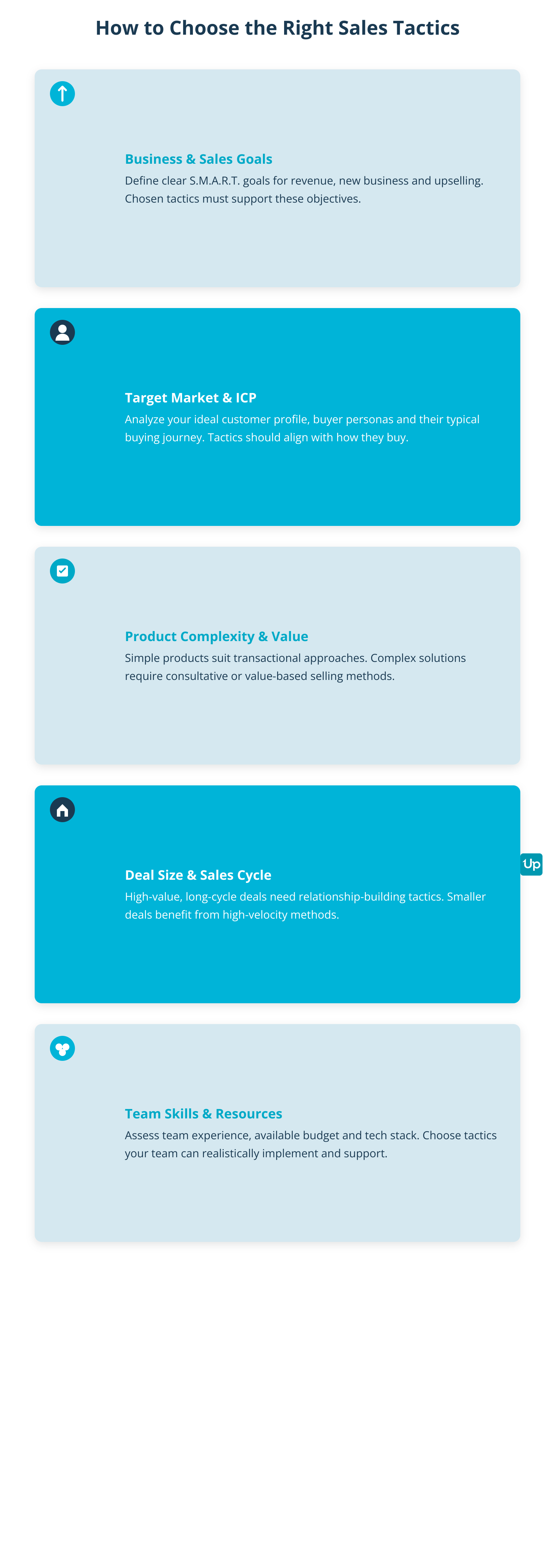
Choosing the Right Sales Tactics
- Business & Sales Goals: Define clear, S.M.A.R.T. (Specific, Measurable, Attainable, Relevant, Timely) goals for revenue, new business and upselling. The chosen tactics must support these objectives.
- Target Market & Ideal Customer Profile: Analyze your ICP, buyer personas and their typical buying journey. The tactics should align with how and where your target customers make purchasing decisions.
- Product/Service Complexity & Value Proposition: Is the offering a simple, transactional product or a complex solution requiring consultation? Complex sales benefit from consultative or value-based approaches.
- Average Deal Size & Sales Cycle Length: High-value deals with long sales cycles (e.g., enterprise software) require relationship-building tactics like Strategic Account Planning or Consultative Selling. Smaller, transactional deals may suit more direct, high-velocity methods.
- Team Skills & Maturity: Assess the current skills, experience level and size of your sales team. Some methodologies, like The Challenger Sale, require advanced skills and training, while others are more straightforward to implement.
- Available Resources & Tech Stack: Consider the budget, tools (e.g., CRM) and time commitment available for training and implementation. The chosen tactics must be supportable by your current tech stack and resources.
Start by testing one or two tactics, measure the results and iterate. Don’t try to implement everything at once.
Key Tools to Power Your Sales Tactics
The right tools can amplify the effectiveness of your sales tactics. Here are the platforms that top-performing teams rely on:
CRM & Sales Automation: HubSpot Sales Hub (all-in-one platform with CRM, sales automation, email tracking and reporting), Salesforce Sales Cloud (enterprise-level CRM with deep customization and robust reporting), Zoho CRM (scalable CRM with sales forecasting and AI assistant Zia), Pipedrive (user-friendly, visual CRM focused on pipeline management).
CRM tools help manage the sales pipeline by providing a structured view of each stage, allowing account executives and marketing teams to collaborate effectively. Building a sales pipeline allows sales and marketing to easily keep track of the status of each potential deal, improving forecasting and efficiency.
Prospecting & Lead Intelligence: UpLead (B2B contact database with 180M+ verified contacts and 95% accuracy guarantee), Apollo.io (all-in-one prospecting platform), ZoomInfo (B2B intelligence platform), LinkedIn Sales Navigator (social selling tool).
Sales Engagement & Enablement: Salesloft (revenue orchestration platform), Outreach.io (sales engagement platform), Highspot (AI-powered sales enablement platform for content, playbooks and coaching), Seismic (sales enablement platform).
Conversation Intelligence: Gong (revenue intelligence platform analyzing sales conversations), Goodmeetings.ai (AI-powered meeting platform with automated recording and transcription).
Specialized Tools: Drift (conversational AI and chatbot platform), Qwilr (interactive sales proposals software), SalesScreen (sales gamification platform), Sendoso (direct mail and gifting platform), Mixmax (sales engagement for Gmail/Outlook).
Sales teams should collaborate across departments to address complex deals and provide comprehensive solutions to prospects.
Choose tools that integrate well with your existing tech stack and support the tactics you’ve prioritized.
How to Measure the Effectiveness of Your Sales Tactics
To measure the effectiveness of sales tactics, track these key performance indicators:
Analyzing sales calls is a valuable method to evaluate and enhance various sales approaches, including other sales tactics, helping to improve overall sales performance.
What Is Conversion Rate?
Conversion rate is the percentage of leads that become paying customers, indicating the effectiveness of the sales funnel. To calculate it, divide the number of converted deals by the total number of leads and multiply by 100.
For example, if you had 100 leads and closed 27 deals, your conversion rate is 27%. A good average conversion rate is between 2% and 5%, but this can vary by industry.
What Is Average Deal Size?
Average deal size is the average monetary value of a closed deal. It helps in revenue forecasting and understanding the value your team brings with each sale. Calculate it by dividing the total value of all closed deals by the number of deals closed in a specific period.
For example, if you close 10 deals for a total of $350,000, the average deal size is $35,000.
What Is Sales Cycle Length?
Sales cycle length measures the average time from the first contact with a prospect to closing the deal. A shorter sales cycle means a more efficient sales process. To calculate it, sum the total number of days it took to close all deals and divide by the total number of deals.
For example, if 4 deals took a total of 200 days to close, the average sales cycle length is 50 days.
What Is Win/Loss Ratio?
Win/loss ratio compares the number of deals won to the number of deals lost. It helps assess your competitive position and strategy effectiveness. To calculate the ratio, divide the number of won opportunities by the number of lost opportunities.
A ratio above 1.0 means you are winning more deals than you are losing.
What Is Lead Response Time?
Lead response time is the average time it takes for a sales representative to follow up with a lead after they’ve shown interest. A fast response is critical; responding within the first five minutes can make you 21 times more likely to qualify a lead compared to responding after 30 minutes.
Track these metrics and use them to identify which tactics are driving results and which need to be adjusted or replaced.
5 High-Pressure Sales Tactics to Avoid at All Costs
Not all tactics are created equal. Some erode trust and damage long-term relationships. Here are the tactics you should avoid:
Dishonesty and Misrepresentation
This includes making false or exaggerated claims about a product’s capabilities, hiding technical issues or misrepresenting facts to deceive customers. For example, claiming a used car has never been in an accident when it has. This practice erodes trust and can lead to a bad reputation.
Creating Fake Urgency and Scarcity
This tactic pressures customers into making impulsive decisions by suggesting an offer is for a “limited time” or that stock is low when it isn’t true. While it might generate quick sales, its consistent use leads to customer mistrust.
Aggressive or Excessive Follow-up
Contacting a prospect after they have stated they are not interested is a high-pressure tactic. This includes making too many phone calls or sending numerous emails and refusing to accept ‘no’ for an answer. This behavior can drive customers away.
Making It Difficult to Say No
This involves using manipulative or guilt-inducing language to pressure a customer into a purchase. It can range from refusing to answer simple questions to making it hard to opt-out of a sale or using passive-aggressive lines that imply the customer will regret their decision.
Talking More Than Listening
When salespeople dominate the conversation, they project a lack of interest in the customer’s actual needs. Rushing through the sales process or talking over the client are high-pressure tactics that signal a focus on commission rather than on solving the customer’s problem.
Top-performing sales professionals listen more than they talk, allowing them to understand the prospect’s pain points and position their solution as the best fit.
Sales Tactics: Conclusion
This article has covered over 27 proven sales tactics that create a solid framework for building a winning sales strategy. From prospecting and engagement to closing and psychological techniques, these tactics are the foundation for growing your company and acquiring leads in the most effective ways.
Before trying any new, creative sales tactic, remember these fundamentals and ensure you’re applying them as best as possible. Start by choosing the tactics that align with your business goals, target market and team capabilities. Test them, measure the results and iterate.
Building a solid relationship with your customers is crucial, not just during the sales process but also after a sale is made. Following up with customers after a sale helps maintain the relationship and ensures their satisfaction.
With enough practice and the right tools, one of these tactics may become your next best sales tactic.
Frequently Asked Questions
What are the most effective B2B sales tactics?
The best sales tactics are those that adapt to the buyer’s needs and context, ensuring a personalized approach throughout the sales process. Effective B2B sales tactics are customer-centric and data-driven. Key tactics include Account-Based Selling (treating each high-value account as a market of one using personalized, multi-channel outreach), Solution Selling (focusing on the customer’s pain points and positioning the product as the ideal solution), Social Selling (using social media platforms to find, connect with and nurture sales prospects), Omnichannel Engagement (creating a seamless customer experience across multiple platforms), and Data-Driven Personalization (using behavioral data to tailor sales conversations and content). It’s important to use different sales tactics for different situations to effectively engage prospects and build trust.
What is the difference between a sales tactic and a sales methodology?
A sales methodology is the overarching philosophy or framework that guides your sales approach (the ‘how’ and ‘why’). Examples include SPIN Selling, the Challenger Sale or Solution Selling. A sales tactic is a specific action or maneuver used to execute that methodology (the ‘what’). For example, within a Solution Selling methodology, a tactic might be to send a case study that mirrors a prospect’s specific problem.
What are some examples of psychological sales tactics?
Psychological tactics leverage cognitive biases to build trust and encourage a purchase decision. Common examples include Social Proof (using customer reviews, testimonials and case studies), Reciprocity (offering something of value for free to create a sense of obligation), Anchoring (establishing a price point early to influence perception of subsequent offers), Scarcity/FOMO (creating urgency by highlighting limited-time offers) and Foot-in-the-Door (starting with a small request to increase likelihood of agreeing to larger requests later).
What will be the impact of AI on sales tactics in 2025?
By 2025, AI is expected to be integral to sales, boosting efficiency and effectiveness. Key impacts include Hyper-Personalization (generative AI analyzing customer data to create customized sales plans and content), Enhanced Productivity (AI automating routine tasks, projected to boost employee productivity by 40%), Predictive Analytics & Forecasting (AI algorithms providing up to 95% accuracy in sales forecasts), Increased Lead Generation (sales teams using AI expected to generate up to 50% more leads and reduce operational costs by 60%) and Rise of AI Assistants (agentic AI functioning as self-directed assistants managing complex workflows).
What is value based selling and why is it effective?
Value based selling is a modern, effective approach that emphasizes highlighting the benefits and outcomes of a product or service tailored to the prospect’s specific needs, rather than just listing features. By understanding customer value and quantifying the benefits, sales teams can build a persuasive case that resonates with buyers and drives better results.
Introduction to Sales
Sales is the engine that drives business growth, connecting companies with potential customers and helping them solve real-world challenges. In today’s competitive landscape, sales professionals must master a variety of sales techniques to build trust, uncover pain points, and deliver solutions that truly resonate. The sales process is no longer just about making a quick sale—it’s about understanding the needs of prospective customers, nurturing strong customer relationships, and ensuring long-term sales success.
Modern sales reps are expected to adapt quickly, leveraging AI-powered tools and data-driven insights to stay ahead of changing buyer behaviors. By focusing on ethical selling practices and genuinely caring about customer outcomes, sales teams can differentiate themselves in crowded markets. Ultimately, a well-executed sales process empowers sales professionals to identify opportunities, address concerns, and provide value at every stage of the customer journey.
Understanding Customer Needs
At the heart of every successful sale is a deep understanding of the customer’s needs, preferences, and motivations. Sales professionals who excel are those who practice active listening, ask thoughtful questions, and analyze customer data to uncover hidden pain points. By taking the time to truly understand what matters most to the customer, sales reps can tailor their sales pitch to highlight how their product or service addresses specific business challenges.
This customer-centric approach not only builds trust but also lays the foundation for long-term relationships and repeat business. Leveraging insights from customer data allows sales teams to personalize their outreach and demonstrate genuine interest in solving the customer’s problems. Additionally, collaboration with the customer success team ensures effective post-sale follow-up, ongoing support, and the identification of cross selling and upselling opportunities. By focusing on the customer’s journey from initial contact to post-sale engagement, sales professionals can drive more sales and create satisfied customers who are eager to refer others.
Body Language and Non-Verbal Cues
In sales conversations, what you say is important—but how you say it can be just as impactful. Body language and non-verbal cues play a crucial role in building rapport and trust with potential customers. Sales reps should be mindful of their posture, facial expressions, and gestures, as these can communicate confidence, enthusiasm, and empathy even before a word is spoken.
Mirroring the customer’s body language, maintaining appropriate eye contact, and using open, welcoming gestures can help put potential buyers at ease and foster a more engaging dialogue. It’s also important for sales professionals to be aware of cultural differences and individual preferences, adapting their approach to suit each unique interaction. By mastering non-verbal communication, sales reps can enhance their sales conversations, strengthen customer relationships, and increase the likelihood of a successful outcome.
Sales Team Management and Performance
A high-performing sales team is the backbone of any successful sales organization. Effective sales team management involves more than just setting targets—it’s about creating a culture of support, motivation, and continuous improvement. Sales leaders should focus on aligning the sales strategy with overall business objectives, providing regular training and coaching, and fostering an environment where sales reps feel empowered to excel.
Leveraging data analytics is key to monitoring performance, identifying trends, and making informed decisions that drive sales success. By tracking key metrics and KPIs, sales leaders can pinpoint areas for improvement and adjust their sales strategy as needed. Recognizing and rewarding outstanding performance not only boosts morale but also encourages healthy competition and drives the entire sales team to achieve their full potential. With the right leadership and support, sales teams can consistently deliver results and contribute to the long-term growth of the business.





